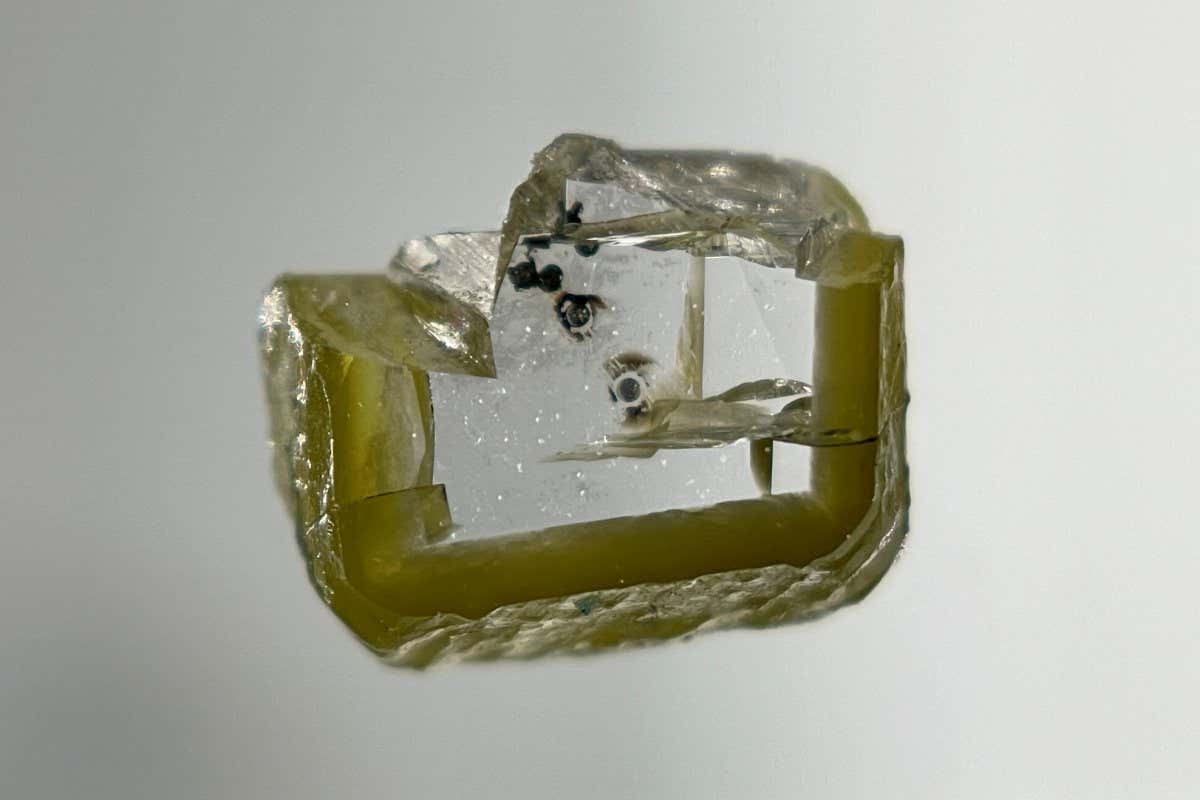Trapped inside a tiny diamond, there are tinier crystals of a never-before-seen mineral that makes up 5 per cent of the lower mantle
Earth 11 November 2021
By Alice Klein
A diamond that had crystals of davemaoite inside it
Aaron Celestian, Natural History Museum of Los Angeles County
An ancient diamond found in Botswana contains a never-before-seen mineral that came from deep inside Earth. The mineral – named davemaoite – provides a unique window into deep-Earth chemistry.
Originally dug up in a mine in Orapa, Botswana, the diamond is about 4 millimetres wide and weighs 81 milligrams. A dealer sold it in 1987 to a scientist at the California Institute of Technology who was studying diamonds, but neither the dealer nor the scientist had any idea how special it was.
The diamond, which is now at the Natural History Museum of Los Angeles County in California, was more recently analysed by Oliver Tschauner at the University of Nevada, Las Vegas. He is searching the world for what are known as “super-deep diamonds” to see what they can tell us about the deep interior of Earth.
Advertisement
Most diamonds form 120 to 250 kilometres underground, but those of the super-deep variety are born in Earth’s lower mantle, which begins 660 kilometres below the surface.
When Tschauner and his colleagues peered into the Botswanan diamond using X-rays, they discovered tiny crystals of another mineral trapped inside. They used a laser to cut into the diamond and extract these crystals, then employed a technique called mass spectrometry to see what they were made of.
The tiny crystals turned out to be a form of calcium silicate that was theorised to exist in the lower mantle but had never actually been observed before. The molecules within it take on a particular cubic arrangement known as a perovskite structure.
The atomic composition of this particular perovskite – which primarily contains calcium, silicon and oxygen – shows it could only have formed under the extreme conditions experienced in the lower mantle, where the pressure is more than 200,000 times that found at Earth’s surface. Under surface conditions, calcium silicate is instead typically found as a white mineral called wollastonite that has needle-like crystals.
Tschauner and his colleagues named the new calcium silicate mineral davemaoite in honour of deep-Earth scientist Ho-Kwang “Dave” Mao at the Carnegie Institution for Science in Washington DC.
Normally, davemaoite’s crystal structure would break apart if it was brought up to Earth’s surface because of the massive drop in pressure. But because it was trapped inside a rigid diamond, it was preserved on its long journey up to the Orapa mine, which probably took between 100 million to 1.5 billion years.
“When we broke open the diamond, the davemaoite stayed intact for about a second, then we saw it expand and bulge under the microscope and basically turn into glass,” says Tschauner.
Davemaoite is thought to make up about 5 per cent of Earth’s lower mantle and is important because it is theorised that the mineral can also host radioactive elements like uranium, thorium and potassium-40 that heat Earth as they decay. “Without these radioactive elements, the Earth would have cooled by now,” says David Phillips at the University of Melbourne in Australia.
The davemaoite found in the Botswanan diamond also contained some sodium and potassium, which is surprising because these elements are thought to mainly reside in Earth’s crust and not deep in the mantle, says Phillips. “This shows that surface material is being recycled back into the mantle.”
Tschauner and other researchers are continuing their hunt for super-deep diamonds in the hope of finding more hidden minerals. This is an arduous process, since there are no simple ways of distinguishing between diamonds with shallow or deep origins, and no way of knowing where the deep variety will be found. “The issue is, we don’t know quite where to look,” says Tschauner.
Journal reference: Science, DOI: 10.1126/science.abm4742
More on these topics:
































